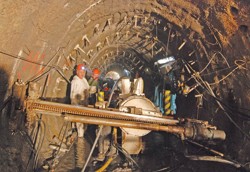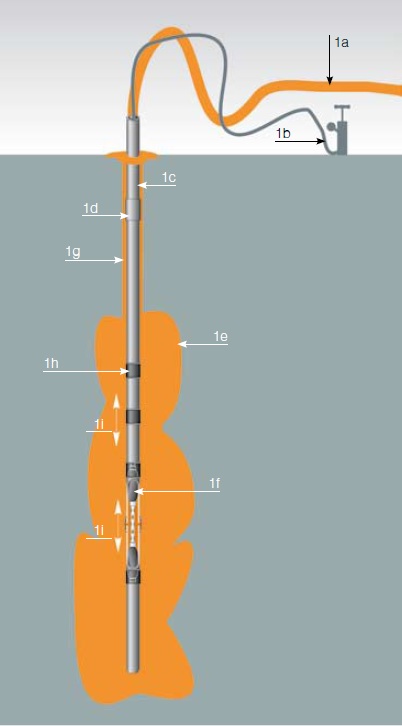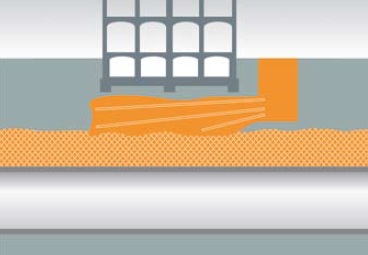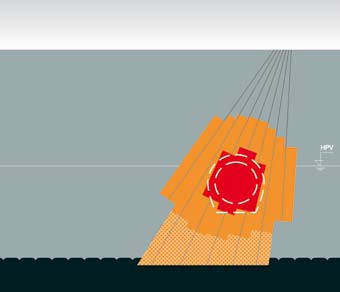
Technologies of grouting improve qualities of foundation soils. In the process of grouting solid rocks a grout mixture is blasted under grouting pressure into the rock, where it fills inpredisposed rock discontinuities, as for example stratification planes, cracks, rifts and other discontinuities. The physical-mechanical parameters of the grouted rock, such as compressive strength or modules of deformation are improved and its permeability is reduced. When non-cohesive soils are grouted, grout mixture fills in porous spaces between soil particles and seals them, thus producing an artificial rock ground-composite. Such grouted non-cohesive rock proves better mechanical qualities and reduced permeability. A bore hole needs to be always drilled for grouting. This holein cohesive soils and solid rocks serves directly for setting either a double or single packer determining the grouted deck. In cases of non-cohesive soils a hole filled with filling is fitted with a tube-a-manchette, which is equipped in the grouted section of the hole with perforation covered with rubber sleeves serving as back flow valves. Stabilised cement mixtures are used to achieve higher compactness, clay-cement mixtures are used for sealing purposes and mixtures on the basis of solutions are used forrock grouting. As a matter of principle, the largest grain of grout mixture must be at least three times smaller than pores of the grouted ground. Grouting pressures, under which the mixture is blasted into the rock, depend on the qualities of grouted environment, qualities of grout mixture and principles of grouting works. Grouting pressure should reach maximum 80 % of shear strength of the grouted environment, so that the grouting processdid not damage rock structure and its character. When cohesive soils are grouted, discontinuities are often created on purpose with grouting pressure by exceeding shear strength of the soil. These discontinuities are speedily filled in with grout mixture with the objective of in creasing the strength, fastening the consolidation and potentially increasing the volume of grouted ground, e.g. with the purpose of lifting construction objects (so called rectification).

Standard grouting
1a) grout mixture inlet
1b) packer control
1c) perforated grouting pipe (tube-a-manchette)
1d) connector
1e) indurated grout mixture
1f) double packer
1g) grout
1h) rubber sleeve
1i) level
Different uses of grouting
2a) strenghtening the subsoil
2b) grouting anchor roots and micropiles
2c) grouting masonry
2d) grouting discontinuities in solid rocks
2e) strengthening vault over burden
in underground works and parallel reduction of ground water in flow

Grouting has a wide scope of use in building practice: sealing impermeable curtains are created by grouting bottoms of dams and other water works, preventing leaks of water from the reservoirs. Grouting creates strengthened and water proof zones over tunnels, galleries and other driven works, which enable speeding of driving proceedings and increase their safety. Grouting is used for reconstructions and repairs of damaged masonry of historical objects, where it helps to increase total solidity of building works. With the development of continuous monitoring the automation of grouting works has been achieved, which enabled their use for rectification and compensation purposes. It is thuspossible to compensate, for example, differential settlement of buildings, or eliminate the influence of driving and tunnelling works on above ground developments.
The grouting technology is an important part of carrying out ground anchors as it ensures their load capacity in the root part in the same way as with the micropiles that are bearing elements of deep foundation. If the realisation of grouting works is to be appropriate and economical, a perfect knowledge of character of the grouted environment and qualities of grout mixture is necessary, as well as immediate reaction to the ground behaviour during the process of grouting works. Grouting can also be used for the maintenance of construction defects. Reinforcement grouting concrete structures uses mainly epoxies, in cases of water seep ages materials on a basis of polyurethanes or hydrophilic polyacrylate gels are used. A compensation grouting is a special type of grouting works. This method is used for levelling overburden drops in subsiding areas of a driven underground work. Their realisation is identical with standard sanitation grouting; however, fans are directed exclusively to the overburden of a driven work and they are drilled from galleries designed for the sanitation grouting. Realisation and control of grouting are directly dependent on monitoring of the overburden, i. e. on the maximum allow able values of its subsidence (This technology was used for the first time in our country for building the road tunnel Mrázovka in Prague).
Levelling drops of overburden in the subsidencezone
of driven underground works usingcompensation grouting

Securing driving of an underground work withstandard
jet grouting under the groundwater level, underground moving-staircase tube

